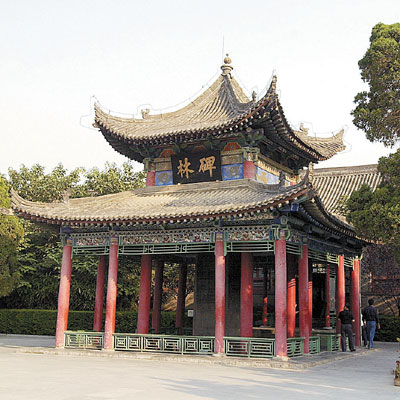Regarded as showcases of ancient Chinese civilization, two museums in Xi'an, the capital of Shaanxi Province, often feature on the itinerary of tourists from home and abroad.
the Forest of Stone Steles Museum
One is the Forest of Stone Steles Museum (FSSM), which is situated near the south gate of the Xi'an City Wall, and the other, the Shaanxi Provincial Museum of History (SPMH), which is located in the southern suburbs of Xi'an.
The two museums are worth a visit by any traveler who wants to learn more about ancient Chinese history and culture.
I first visited the two museums on a lone trip in the summer of 1995. But, 12 years later, I found I could experience the same excitement I felt on my first trip.
The admission ticket for the FSSM is 45 yuan (US$6), and for the SPMH, 35 yuan. Since the latter is only about 20 minutes' drive from the former, the two museums can be seen with a little haste in half a day or with ease in one whole day.
When my friends and I visited the FSSM on the morning of Sept. 23, I noticed the museum was still much as it was 12 years ago.
Once the site of the Temple of Confucius during the Northern Song Dynasty (960-1127), the FSSM was initially established in 1087 when a number of precious stone steles were moved there.
Because it houses such a large collection of stone steles from different periods from the Han Dynasty (206 B.C.-25) to the Qing Dynasty (1644-1912), the museum was given the current official name in 1992.
Today, there are about 3,000 steles housed in the museum on display in seven exhibition halls.
At the entrance to the exhibition halls, there is a pavilion which houses the stele of the "Classic on Filial Piety" written by Emperor Xuanzong in 745.
In the first exhibition hall, we saw the 114 steles of the so-called "stone classics," which include "The Book of Changes," "The Book of History," "The Book of Songs," "The Analects of Confucius" and some other must-read books for intellectuals in ancient China.
In the second exhibition hall, we saw the stone tablets written by master calligraphers of the Tang Dynasty (618-907) such as Ouyang Xun, Yan Zhenqing, Liu Gongquan, Zhang Xu and Huai Su.
Here I also found the Nestorian Tablet, which records the early spread of Christianity in China.
As an extension of the second exhibition hall, the third exhibition hall houses various tablets which aim to show the evolution of Chinese characters and development of different styles of Chinese calligraphy.
In the fourth exhibition hall, we watched workers making rubbings of calligraphic works carved in stone tablets. These rubbings are all for sale.
When we entered the gate of the SPMH in the afternoon of Sept. 22, I noticed a sign saying the museum's two-storied main exhibition hall was undergoing renovations.
Built in 1995, the SPMH is one of the best three provincial museums in China, along with the Shenyang Imperial Palace Museum in Liaoning Province and the Nanjing Municipal Museum in Jiangsu Province.
"Shaanxi Province is usually considered the birthplace of ancient Chinese civilization," said a woman guide named Zhang, in her early 20s, from the SPMH.
The city of Xi'an, in the heart of Shaanxi Province, is well known as having been the capital city for a total of 13 dynasties lasting more than 1,100 years from the Qin Dynasty (221 B.C.-206 B.C.) to the Tang Dynasty.
"The history of Shaaxi Province is actually a shortened version of ancient Chinese history," Zhang said.
What impressed every visitor first with the SPMH was the grand complex of buildings in the architectural style of the Tang Dynasty.
With black, white and grey as the dominant colors, the buildings have a simple but solemn charm.
Because of the renovations, all exhibits in the main exhibition hall had been moved to the western and eastern exhibition halls and would be moved back after the renovations were completed early next year, Zhang said.
Zhang then led us through the theme exhibitions in the western and eastern exhibition halls.
The theme exhibitions are in chronological order, beginning from primitive times of 1.7 million years ago through to the end of the Qing Dynasty.
After a tour of one and a half hours, the numerous exquisite relics on display I was completely dazzled.
Among the relics from prehistoric times, the highlights were a fossil skull of a Lantian Man, which is the oldest example of homo erectus found in Asia, and a painted water basin with a human mask and fish patterns, which was excavated at the prehistoric Banpo Village site Shaaxi Province in 1950s.
Among the relics of the Sui and Tang Dynasties, the highlights include porcelain figurines of plump women and the tricolored glazed porcelain horses.
(Shenzhen Daily by Newman Huo November 15, 2007)


